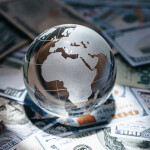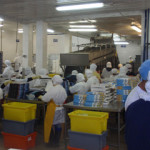The 13th Seafood and Technology Expo OSAKA was held on 18 and 19 February, in conjunction with the 9th Agri-food Expo Osaka. The two shows shared space at the Asia-Pacific Trade Center (ATC Hall). Over the two days, 15,490 visitors attended, up from 14,956 last year.
The Osaka show is smaller than the affiliated 18th Japan International Seafood & Technology Expo, to take place 17-19 August at Tokyo Big Sight. Both shows are sponsored by the Japan Fisheries Association.
There were not many eye-catching displays among the seafood vendors, perhaps because booth spaces were small. The display area is quite confined, with passages occasionally too crowded to pass.
Nor were many exciting new seafood products introduced, probably due to the local nature of the show. The larger Tokyo show is the place to introduce new products; seafood vendors in Western Japan use the Osaka show as a convenient place to meet with many of their existing customers at once.
However, this is not just a “seafood” show, but also a “technology” show, and there was some interesting machinery on view.
Liquid Freezer – The TOMIN line of “liquid freezers” by Yokohama-based Technican Co., Ltd. uses ethyl alcohol to achieve quality on a par with liquid nitrogen freezers, and at similar speeds, but at a running cost of 3 to 5 yen per kilogram of product (USD 0.03-0.04, EUR 0.02-0.04). Ethyl alcohol has a freezing point lower than water, so it can freeze seafood while it remains liquid – important since liquid has 20 times the thermal conductivity of air.
Rapid freezing results in smaller ice crystals that do less damage to cell walls. When cell walls are undamaged, drip loss is reduced. Technican sales director Takayuki Aoki said that drip sheets can be eliminated, while frozen product life can be extended to 3 years for meats and up to 7 years for seafood.
Shocking Net – Tokyo-based Nichimo Co., Ltd. has made a system to electrify the net basket used to harvest farmed seafood. While fish are being raised from the aquaculture pen to the processing table, a strong charge is passed from a metal mesh on one side of the net through the fish to a grounded mesh on the other side, killing the fish. Manager Satoshi Ikeda said that the benefits are reduced bruising resulting in higher yields, easier handling and lower stress. Stress produces chemical changes that result in poor flavor and faster spoilage. He said that large overseas aquaculture facilities use suction tubes with in-line shocking, but for the small batch handling more common in Japan, the net system is suitable.
Uncertified Sashimi Slicer – The need for UL safety certification prior to entering the U.S. market has proved an obstacle to Fillestar Co., Ltd., effectively preventing it from exporting its new automatic sashimi slicer. The machine, featuring rows of razor sharp stainless steel blades that can slice a whole sashimi block in a single pass, looks like something that one would want to have safety-checked. “Just don’t put your hand in it,” the salesman says. But for low-volume export sales, it hasn’t been worth the investment in inspection and annual fees. Licensing the design instead is a possible future route.
Ice Bowl – The “Ice Lyza” and its larger cousin, “Ice Vessel” are hand-operated presses for forming shaved ice into an ice bowl. The bowl can be used as a display for sashimi or other cold dishes. The maker, Niigata-based Akashi Denka Corp., also offers an attachable ice shaver. Department manager Takeo Ozawa said that the machine has been exported to hotels in Las Vegas and Los Angeles. The trick to operating it is not to be timid, but to slam the die into the mold at speed.
“At first, we tried using a large hydraulic press, but there would be rebound after it was released and the bowl would break up. Then, we figured out that it is the force of impact rather than sustained pressure that binds the ice together,” he said.
Minus Ion Water – Tamura Co., Ltd. displayed its ion-grounding water treatment system, “Dileka.” Water flows over copper baffles with an earth connection, discharging positive ions. The resulting water is claimed to improve the quality of live oysters held in post-harvest tanks by preventing oxidation and retarding germs. Negative ions are widely believed to have positive health effects in Japan, though the U.S. bans human health claims due to a lack of clinical data.






